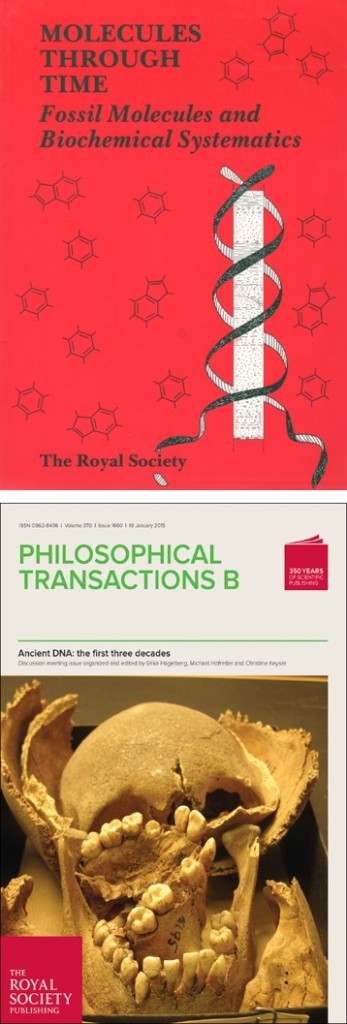To celebrate 350 years of scientific publishing, we are inviting our readers to tell us about papers from the Royal Society archive.

The Philosophical Transactions of the Royal Society has a special significance for me, as I have contributed to three theme issues that encompass the development of my field, ancient DNA research, through a quarter of a century.

Cover designs have also changed over time!
Molecules Through Time (1991) was devoted to the investigation of informative biomolecules in fossil organisms. The topics included the survival and analysis of glycolipids, lipopolysaccharides, proteins, DNA and other complex molecules in materials as diverse as marine sediments, oil shale and the carcasses of Siberian mammoths. I was a young postdoctoral research associate in Oxford, and contributed one of two papers devoted to the analysis of DNA from ancient human bone. The second was by the late Satoshi Horai. Less than two years previously he and I reported independently the successful amplification of DNA from archaeological bones. Ancient DNA was a young discipline, and the few researchers were young Turks among the older and established chemists, geneticists, zoologists, and geologists. We faced hard technical questions on DNA degradation, contamination, and the evolutionary significance of our findings, findings that at the time were novel, exciting and even surprising. In the following years, I worked on the applications of bone DNA typing, including the first instance of the identification of a murder victim by DNA analysis (with Sir Alec Jeffreys), the origins of the prehistoric Easter Islanders and the phylogenetic relationships of mammoths.
Several years later, I was co-organizer and editor of Molecular Information and Prehistory (1999). This included some of the contributors to the earlier theme issue, but many more articles were devoted to DNA studies. In the intervening time, there had been several large research initiatives on ancient DNA; scientists had investigated a variety of DNA sources, including plant seeds and animal bones, to help understand the history of farming and domestication. Several articles in the issue deal with the study of human migrations using information from DNA of living populations, rather than ancient human DNA. At about this time, the late nineteen-nineties, the field of ancient DNA went through the doldrums as scientists became increasingly worried about contamination, and skeptical about studies on ancient human DNA. Being one of the pioneers of the subject, I found this disappointing, as I knew bone DNA typing had huge unrealised potential in many types of historical and evolutionary studies. After all, in 1997 researchers had reported the first, albeit short, DNA sequence from the bone of a Neanderthal, and it was clear that the work, even if technically challenging, was feasible.
Technical developments, notably next-generation DNA sequencing, helped dispel the gloom surrounding ancient DNA research. The new techniques permit the analysis of very short DNA pieces, typical of ancient biological materials, to reconstruct whole genomes of extinct organisms with the aid of bioinformatics tools. This spurred me to organize and edit a theme issue dedicated specifically to ancient DNA research, Ancient DNA: the first three decades (2015). Here, my co-editors and I gathered contributions on topics as diverse as animal domestication, ancient diseases, Neolithic farmers, Vikings, peat sediments, and the evolution of farming. Also gratifying was the fact that whereas in 1991 I was the only woman contributor, over half the contributions to our ancient DNA anniversary volume were by women.
